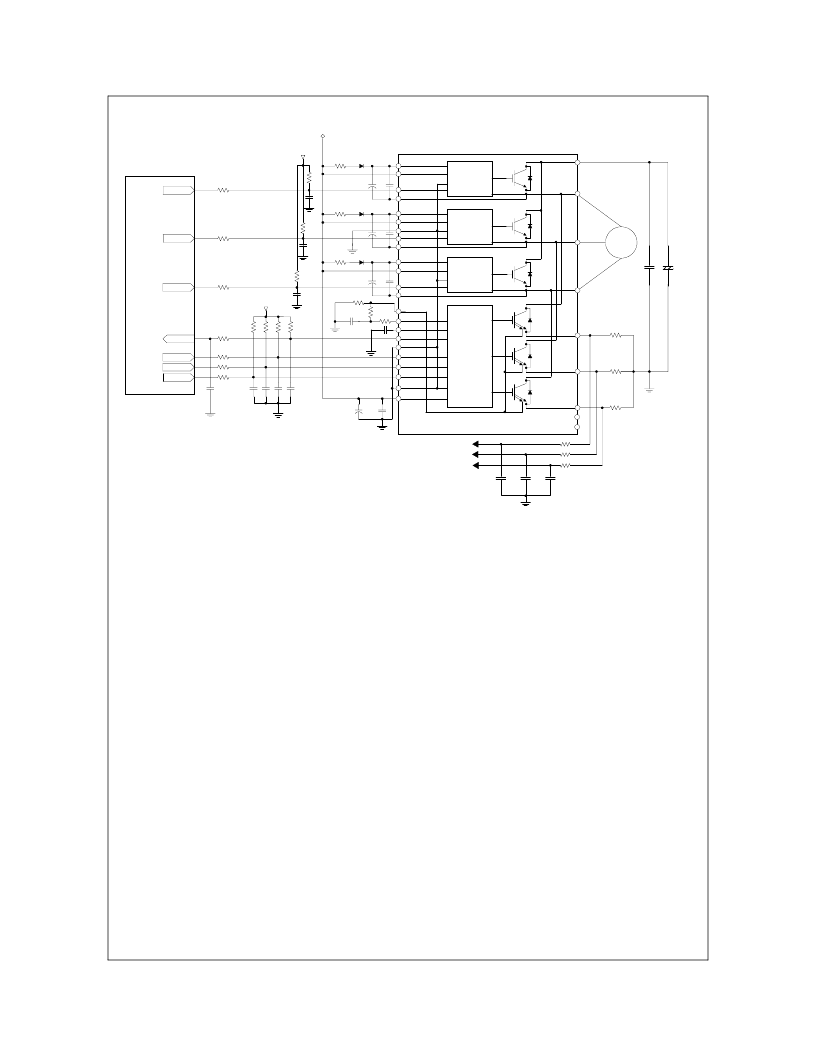- 您現(xiàn)在的位置:買(mǎi)賣(mài)IC網(wǎng) > PDF目錄375930 > FSBM20SL60 (FAIRCHILD SEMICONDUCTOR CORP) SPMTM (Smart Power Module) PDF資料下載
參數(shù)資料
| 型號(hào): | FSBM20SL60 |
| 廠商: | FAIRCHILD SEMICONDUCTOR CORP |
| 元件分類(lèi): | 運(yùn)動(dòng)控制電子 |
| 英文描述: | SPMTM (Smart Power Module) |
| 中文描述: | AC MOTOR CONTROLLER, 40 A, DMA32 |
| 文件頁(yè)數(shù): | 14/16頁(yè) |
| 文件大小: | 1626K |
| 代理商: | FSBM20SL60 |
第1頁(yè)第2頁(yè)第3頁(yè)第4頁(yè)第5頁(yè)第6頁(yè)第7頁(yè)第8頁(yè)第9頁(yè)第10頁(yè)第11頁(yè)第12頁(yè)第13頁(yè)當(dāng)前第14頁(yè)第15頁(yè)第16頁(yè)

2003 Fairchild Semiconductor Corporation
F
Rev. D, August 2003
Note:
1) R
C
/R
C
PH
/R
PF
C
PF
coupling at each SPM input is recommended in order to prevent input signals’ oscillation and it should be as close as possible to each
SPM input pin.
2) By virtue of integrating an application specific type HVIC inside the SPM, direct coupling to CPU terminals without any opto-coupler or transformer isolation is
possible.
3) V
output is open collector type. This signal line should be pulled up to the positive side of the 5V power supply with approximately 4.7k
resistance. Please
refer to Fig. 14.
4) C
SP15
of around 7 times larger than bootstrap capacitor C
is recommended.
5) V
FO
output pulse width should be determined by connecting an external capacitor(C
FOD
) between C
FOD
(pin8) and COM
(L)
(pin2). (Example : if C
FOD
= 33 nF, then
t
= 1.8 ms (typ.)) Please refer to the note 6 for calculation method.
6) Each input signal line should be pulled up to the 5V power supply with approximately 4.7k
resistance (other RC coupling circuits at each input may be needed
depending on the PWM control scheme used and on the wiring impedance of the system’s printed circuit board). Approximately a 0.22~2nF by-pass capacitor
should be used across each power supply connection terminals.
7) To prevent errors of the protection function, the wiring around R
, R
and C
should be as short as possible.
8) In the short-circuit protection circuit, please select the R
C
time constant in the range 3~4
μ
s.
9) To enhance the noise immunity, C
pin should be connected to the external circuit through a series resistor, R
CSC
, which is approximately 390
. R
CSC
should
be connected to C
pin as close as possible.
10)Each capacitor should be mounted as close to the pins of the SPM as possible.
11)To prevent surge destruction, the wiring between the smoothing capacitor and the P&N pins should be as short as possible. The use of a high frequency non-
inductive capacitor of around 0.1~0.22 uF between the P&N pins is recommended.
12)Relays are used at almost every systems of electrical equipments of home appliances. In these cases, there should be sufficient distance between the CPU and
the relays. It is recommended that the distance be 5cm at least.
Fig. 14. Typical Application Circuit
COM(L)
VCC
IN(UL)
IN(VL)
IN(WL)
VFO
C(FOD)
C(SC)
OUT(UL)
OUT(VL)
OUT(WL)
N
U
(26)
N
V
(27)
N
W
(28)
U (29)
V (30)
W (31)
P (32)
(23) V
S(W)
(22) V
B(W)
(19) V
S(V)
(18) V
B(V)
(9) C
SC
(8) C
FOD
(7) V
FO
(5) IN
(WL)
(4) IN
(VL)
(3) IN
(UL)
(2) COM
(L)
(1) V
CC(L)
(10) R
SC
NC (24)
NC (25)
(6) COM
(L)
VCC
VB
OUT
COM
IN
VS
VB
VS
OUT
IN
COM
VCC
VCC
VB
OUT
COM
IN
VS
(21) V
CC(WH)
(20) IN
(WH)
(17) V
CC(VH)
(15) IN
(VH)
(16) COM
(H)
(14) V
S(U)
(13) V
B(U)
(12) V
CC(UH)
(11) IN
(UH)
Fault
15V line
C
BS
C
BSC
R
BS
D
BS
C
BS
C
BSC
R
BS
D
BS
C
BS
C
BSC
R
BS
D
BS
C
SP15
C
SPC15
C
FOD
5V line
R
PF
C
PL
C
BPF
R
PL
R
PL
R
PL
C
PL
C
PL
5V line
C
PH
R
PH
C
PH
R
PH
C
PH
R
PH
R
S
R
S
R
S
R
S
R
S
R
S
R
S
M
Vdc
C
DCS
Gating UH
Gating VH
Gating WH
Gating WH
Gating VH
Gating UH
C
PF
C
P
U
R
FU
R
FV
R
FW
R
SU
R
SV
R
SW
C
FU
C
FV
C
FW
W-Phase Current
V-Phase Current
U-Phase Current
R
F
C
SC
R
SC
R
CSC
相關(guān)PDF資料 |
PDF描述 |
|---|---|
| FSBM20SM60A | SPM (Smart Power Module) |
| FSBM30SH60 | 16 Characters x 4 Lines, 5x7 Dot Matrix Character and Cursor |
| FSBM30SH60A | 16 Characters x 4 Lines, 5x7 Dot Matrix Character and Cursor |
| FSBM30SM60A | SPM (Smart Power Module) |
| FSBS10CH60 | Smart Power Module |
相關(guān)代理商/技術(shù)參數(shù) |
參數(shù)描述 |
|---|---|
| FSBM20SM60A | 功能描述:IGBT 晶體管 600V/2A/ SPM2 RoHS:否 制造商:Fairchild Semiconductor 配置: 集電極—發(fā)射極最大電壓 VCEO:650 V 集電極—射極飽和電壓:2.3 V 柵極/發(fā)射極最大電壓:20 V 在25 C的連續(xù)集電極電流:150 A 柵極—射極漏泄電流:400 nA 功率耗散:187 W 最大工作溫度: 封裝 / 箱體:TO-247 封裝:Tube |
| FSBM30SH60 | 制造商:FAIRCHILD 制造商全稱(chēng):Fairchild Semiconductor 功能描述:SPMTM (Smart Power Module) |
| FSBM30SH60A | 功能描述:IGBT 晶體管 600V/30A/ SPM2 RoHS:否 制造商:Fairchild Semiconductor 配置: 集電極—發(fā)射極最大電壓 VCEO:650 V 集電極—射極飽和電壓:2.3 V 柵極/發(fā)射極最大電壓:20 V 在25 C的連續(xù)集電極電流:150 A 柵極—射極漏泄電流:400 nA 功率耗散:187 W 最大工作溫度: 封裝 / 箱體:TO-247 封裝:Tube |
| FSBM30SM60A | 功能描述:IGBT 晶體管 600V/30A/ SPM2 RoHS:否 制造商:Fairchild Semiconductor 配置: 集電極—發(fā)射極最大電壓 VCEO:650 V 集電極—射極飽和電壓:2.3 V 柵極/發(fā)射極最大電壓:20 V 在25 C的連續(xù)集電極電流:150 A 柵極—射極漏泄電流:400 nA 功率耗散:187 W 最大工作溫度: 封裝 / 箱體:TO-247 封裝:Tube |
| FSBNC1RA | 制造商:Belden Inc 功能描述:BNC 1RGB RT. ANGLE MULTI |
發(fā)布緊急采購(gòu),3分鐘左右您將得到回復(fù)。